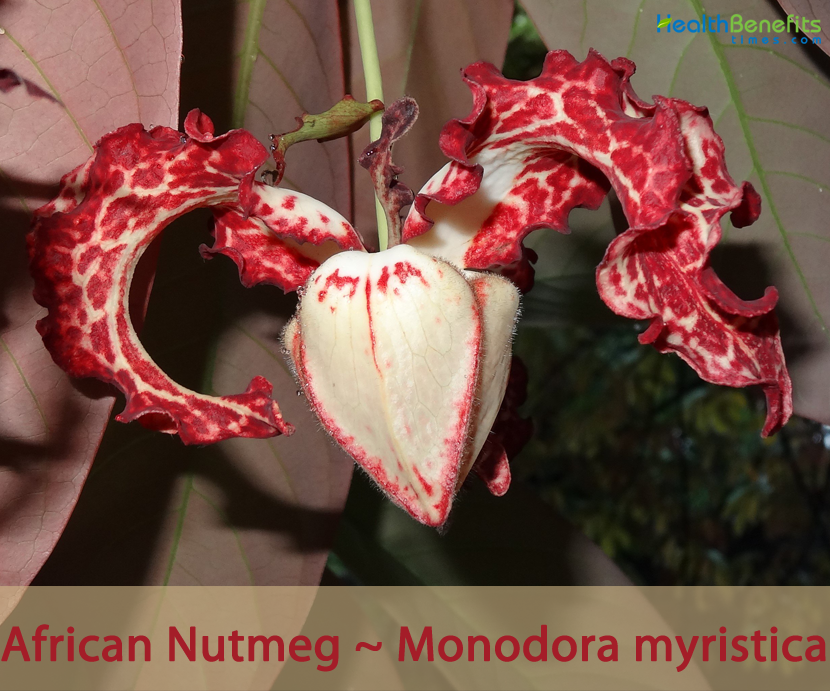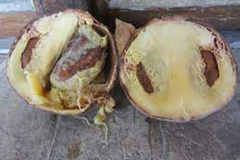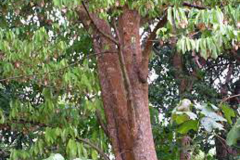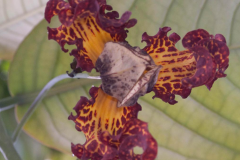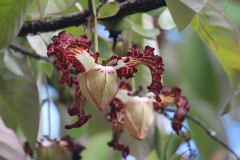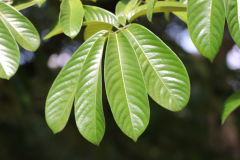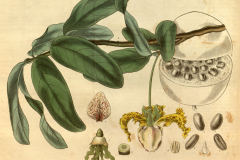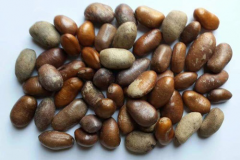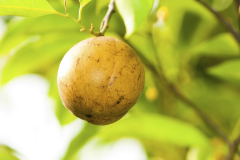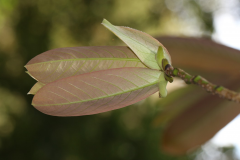Some of the popular common names of the plants are Jamaican nutmeg, African nutmeg, ehuru, ariwo, awerewa, ehiri, airama, African orchid nutmeg, muscadier de Calabash and lubushi, Calabash nutmeg, False nutmeg, Owere seeds and African false nutmeg. Genus name Monodora means ‘only one gift’ in Greek, indicating the solitary fruit. Specific epithet myristica is the genus name of the nutmeg, probably referring that the seeds of this plant have a similar scent and taste of the real nutmeg.
African Nutmeg Facts
| African Nutmeg Quick Facts | |
|---|---|
| Name: | African Nutmeg |
| Scientific Name: | Monodora myristica |
| Origin | Angola, Benin, Cameroon, the Central African Republic, the Democratic Republic of the Congo, Equatorial Guinea, Gabon, Ghana, Guinea-Bissau, Ivory Coast, Kenya, Liberia, Nigeria, the Republic of the Congo, Sierra Leone, Sudan, Tanzania, Togo and Uganda. |
| Colors | Smooth, green with white spots when young turning to pale yellow woody at maturity |
| Shapes | Large spherical, and woody berry measuring about 20 cm in diameter. It is attached to a long stalk which is up to 60 cm long |
| Flesh colors | Whitish fragrant pulp |
| Health benefits | As a cold medicine, Overcoming insomnia, Smooth digestion, Overcome vomiting, Relieves Pain, Overcoming stomach acid, Good nutrition for the brain, As detoxification, Relieve Constipation, Improves Cardiovascular Functions, Promotes Cerebral Ability, Promotes Sexuality, Reduces Cholesterol Levels, Easy Bowel Movement, Weight Management, Controls Blood Sugar, Treat Headache, Managing Sickle Cell Anemia, Treating Arthritis and Rheumatism, Good for New Mothers, Hemorrhoids Treatment |
| Name | African Nutmeg |
|---|---|
| Scientific Name | Monodora myristica |
| Native | Angola, Benin, Cameroon, the Central African Republic, the Democratic Republic of the Congo, Equatorial Guinea, Gabon, Ghana, Guinea-Bissau, Ivory Coast, Kenya, Liberia, Nigeria, the Republic of the Congo, Sierra Leone, Sudan, Tanzania, Togo and Uganda |
| Common Names | Jamaican nutmeg, African nutmeg, ehuru, ariwo, awerewa, ehiri, airama, African orchid nutmeg, muscadier de Calabash and lubushi, Calabash nutmeg, False nutmeg, Owere seeds and African false nutmeg |
| Name in Other Languages | Chinese: Jiǎ ròu dòukòu (假肉荳蔻) English: African nutmeg, Calabash nutmeg, False nutmeg, Jamaica nutmeg, Owere seeds, African false nutmeg, Ehuru French: Fausse noix de muscade, Faux muscadier, Monodora à racine odoriférante sucrée, Muscade-calebasse, Muscade Jamaïque, Muscadier du Gabon, Muscadier de Calabash, mbende, muscade de calabash, muscadier faux German: Kalebassenmuskat, Kalebassen-Muskatnuß, Kalebassen-Muskatnußbaum, Kalabassenmuskat Hausa: Gujiyar dan miya Manx: Gboite Persian: جوز کالاباش Portuguese: Falsa moscadeira, Gipepe, Mepepe, N’zingo Spanish: Ene moso, Moscadero de Africa, Nepravi muškatovec, nuez moscada de Antillas, nuez moscada de las Antillas Swedish: Kalebassmuskot Thai: Kradạngngā xæfrikā (กระดังงาแอฟริกา) Twi: Awerewa Yoruba: Abo-lakoshe Others (Unidentified): Annehia (Ivory Coast), Bende bende (Congo), Deng (Cameroon), Mbende bende (Congo), Moué (Ivory Coast), Ozek (Cameroon) |
| Plant Growth Habit | Deciduous, evergreen, medium to large sized tree |
| Growing Climates | Evergreen, deciduous forest, primary and secondary forests on sandy to rocky soils, mostly along rivers or in swampy regions |
| Plant Size | Up to 35, sometimes up to 40 meters. It has breast height diameter of about 40 to 100 centimeters |
| Bark | Bark thin and smooth, slash white |
| Wood | Wood is white or greyish, hard, somewhat tough and does not split well |
| Trunk | The cylindrical, slightly grooved trunk has a brownish to greyish bark, which has a gray-blue wax coating on the branches. Older twigs are ash gray to brown |
| Leaf | Alternate leaves that occur on the twigs are divided into petiole and leaf blade. The simple, slightly leathery leaf blade is about 11-50 cm long and 4-14 cm wide, obovate to elliptical or narrowly elliptical, its base slightly heart-shaped to rounded, less often cuneiform. The leaf tip is pointed to tip or tailed; the tip up to 10 to 15 millimeters long. Upper side (adaxial surface) of the leaf is dark-green, while the underside (abaxial surface) is paler, with clearly protruding leaf veins |
| Flower | The flower appears at the base of new shoots and is singular, pendant, large and fragrant. The pedicel bears a leaf-like bract and can reach 20 cm in length. The flower’s sepals are red-spotted, crisped and 2.5 cm long. The corolla is formed of six petals of which the three outer reach a length of 10 cm and show curled margins and red, green and yellow spots. The three inner petals are almost triangular and form a white-yellowish cone which on the outside is red-spotted and green on the inside |
| Fruit Shape & Size | Large and woody berry measuring about 20 cm in diameter. It is attached to a long stalk which is up to 60 cm long |
| Fruit Color | Smooth, green with white spots when young turning to pale yellow woody at maturity |
| Flesh Color | Whitish fragrant pulp |
| Seed | Numerous oblongoid, pale brown, 1.5 – 2.2 cm long seeds are surrounded by a whitish fragrant pulp which has a sweet scent |
| Plant Parts Used | Fruits, Edible Seeds |
| Health benefits |
|
| Season | April to June |
| Precautions |
|
Plant Description
African Nutmeg is a deciduous, evergreen, and medium to large sized tree that normally grows up to 35, sometimes up to 40 meters tall. It has breast height diameter of about 40 to 100 centimeters. The plant is found growing in evergreen, deciduous forest, primary and secondary forests on sandy to rocky soils, mostly along rivers or in swampy regions. It has a clear trunk and branches horizontally. The cylindrical, slightly grooved trunk has a brownish to greyish bark, which has a gray-blue wax coating on the branches. Older twigs are ash gray to brown. The wood is white or greyish, hard, somewhat tough and does not split well.
Leaves
The alternate leaves that occur on the twigs are divided into petiole and leaf blade. The simple, slightly leathery leaf blade is about 11-50 cm long and 4-14 cm wide, obovate to elliptical or narrowly elliptical, its base slightly heart-shaped to rounded, less often cuneiform. The leaf tip is pointed to tip or tailed; the tip up to 10 to 15 millimeters long. Upper side (adaxial surface) of the leaf is dark-green, while the underside (abaxial surface) is paler, with clearly protruding leaf veins. New leaves are purplish in color. The petiole reaches 8 to 14 millimeters in length and is furrowed on the upper side.
Flowers
The flower appears at the base of new shoots and is singular, pendant, large and fragrant. The pedicel bears a leaf-like bract and can reach 20 cm in length. The flower’s sepals are red-spotted, crisped and 2.5 cm long. The corolla is formed of six petals of which the three outer reach a length of 10 cm and show curled margins and red, green and yellow spots. The three inner petals are almost triangular and form a white-yellowish cone which on the outside is red-spotted and green on the inside. The numerous short stamens sit in 16 to 20 rows on the ovoid flower axis above; they are about 2 millimeters long. The superior, green ovary towers over the stamens, it is about 4 to 5 millimeters long and just as wide. The divided stigma is relatively small. African Nutmeg flowers and bears fruit all year round. The showy flowers are known to be pollinated by flies.
Fruit and seeds
Fertile flowers are followed by large and woody berry measuring about 20 cm in diameter. It is attached to a long stalk which is up to 60 cm long. Fruits are spherical, smooth, green with white spots when young turning to pale yellow woody at maturity. They are finely ribbed lengthwise. Inside the fruit the numerous oblongoid, pale brown, 1.5 – 2.2 cm long seeds are surrounded by a whitish fragrant pulp which has a sweet scent. It has been observed that an average of 119-122 seeds can be found in one fruit. The very hard and stable fruits are only used by larger, fruit-eating species such as chimpanzees. The seeds consist of 5 to 9% of a colorless essential oil. Fruiting normally occurs from August-November.
Health Benefits of African Nutmeg
Because of its complete content, this fruit has many health benefits. Listed below are some of the benefits that can be obtained from African nutmeg
1. As a cold medicine
African Nutmeg fruit has almost the same benefits as ginger that can eliminate cold and flu. This fruit can warm the body and treat flatulence due to colds. Additionally, this is also due to the essential oil content in the nutmeg. To eliminate the colds, African Nutmeg can be consumed in the form of beverages.
2. Overcoming insomnia
Insomnia is a sleep-related disease. Insomnia not only causes the sufferer difficulty sleeping but also has poor sleep quality. If insomnia is not addressed properly, it will affect the quality of life and also the incidence of various diseases. To eliminate insomnia consume African Nutmeg.
3. Smooth digestion
Enzyme lipase not only can increase one’s appetite, but this enzyme also can launch human digestion. With the help of this enzyme, foods that enter the body will be easily digested and mashed. Therefore, it is highly recommended to consume African Nutmeg before meals.
4. Overcome vomiting
For those of you who are experiencing nausea and vomiting due to motion sickness or for other reasons, you can try to consume African Nutmeg. This fruit has antiemetic properties that can relieve nausea and also vomit.
5. Relieves Pain
African Nutmeg seeds are used to treat stomach-aches. It does this through its anti-inflammatory properties as well as the phytonutrients it contains. Some nuts and seeds have been found to successfully relieve pain due to the omega-3 fatty acids they contain. They block the pain receptors from receiving the signal ergo the consumer doesn’t feel the pain anymore. African Nutmeg seed is known traditionally to successfully treat stomach-aches, headaches and other forms of pain in the body.
6. Overcoming stomach acid
High stomach acid can cause a person to become nauseated and the onset of stomach pain in the stomach. These symptoms are usually experienced by people who suffer from ulcer disease. To overcome consume a drink of African Nutmeg. Because this fruit contains saponins that can reduce stomach acid in a person.
7. Promotes Sexuality
African Nutmeg seeds have been used to treat men who have erectile dysfunction traditionally for a long time. Recently, its efficacy as an aphrodisiac has been proven, although more research will be needed before conclusion can be drawn, that it improves a man’s sexual performance. African Nutmeg seed is high in Zinc which is an important nutrient in controlling the testosterone level in men. In women, zinc relaxes the mind and allows the woman prepare for sex easily. Vitamin C, also found in African Nutmeg seed, improves sperm count and sperm quality.
8. Good nutrition for the brain
African Nutmeg is good for the brain. Fruit consists of a myristin that can reduce the decline in brain function. Surely this is very good for people with Alzheimer’s, Parkinson’s, and also dementia.
9. As detoxification
Consuming African Nutmeg is quite beneficial in the process of removing toxins from the body or detoxification. Actually, detoxification can be done in various ways such as drinking warm water, consuming vegetables and fruits, or by drinking lemon water. The detoxification process will be excreted through urine, feces, and sweat.
10. Relieve Constipation
African Nutmeg seeds are great for relieving constipation, diarrhea, and related issues. Eating soups or any food that contains African Nutmeg seeds can help find fast and effective relief from constipation.
11. Improves Cardiovascular Functions
Normally foods high in cholesterol causes high fat deposits in the blood vessels, giving the heart a hard time to pump blood with enough force that will get the blood over those deposits and to their target organs. African Nutmeg seed is high in fat but has no cholesterol, making it an excellent food choice for promoting heart health. It is also a great source of fiber and magnesium, important nutrients that promote heart health.
12. Promotes Cerebral Ability
The intelligence and response center of the body should be taken care of. Brain needs some nutrients to perform optimally. Some of these nutrients are contained in African Nutmeg seeds.
Some days, we wake up feeling sluggish. This is because the brain has been deprived of adequate nutrient (in some cases) and rest. Nutrients such as Magnesium, Zinc, Iron, and Copper are essential to the improved health of the brain. Copper is specifically known to be influential in controlling nerve signals originating from the brain. Drop in the required level may lead to neurodegenerative disorders like AlzheimerMagnesium improves memory and learning. Deficiency of it leads to migraines and depression. A deficiency of Zinc may lead to neurological degenerative disorders as its work is similar to coppers. African Nutmeg seed is abundant in these nutrients and is therefore a powerhouse for brain-power improvement.
13. Reduces Cholesterol Levels
Eating African Nutmeg seeds can also help to reduce cholesterol levels in the body. Bad cholesterol could lead to heart disease, chest pain, and even stroke. To prevent that, you can eat foods containing African Nutmeg seeds. This would help bring your cholesterol levels down. They contain essential nutrients like iron, flavonoids and potassium.
14. Easy Bowel Movement
One of the perks of consuming adequate quantity of African Nutmeg seed, and consistently is the ease with which it allows you to empty your colon. This is due to the fats and fiber it contains in high quantity.
Fiber makes digestion easy and adds mass to your fecal matter while fats make it easy to move the waste from the colon out of the body.
15. Weight Management
Gaining control of one’s weight is not an easy thing. It is, however, possible when you follow the right diet and eat the right foods. Consume simple carbs; instead, eat complex carbs as they are high in energy and fiber. They also contain some protein. These constituents of complex carbs help you manage your hunger and thus your food consumption.
African Nutmeg seeds are high in energy, fats, and fiber, making them good for weight management. It even gets better as they do not contain any cholesterol. Other important micro-nutrients such as zinc, phosphorus, vitamin c, and others help to maintain metabolic activity even during inactivity.
16. Controls Blood Sugar
Blood sugar level in the blood is controlled by Insulin. Insulin level in the blood is usually high when you feel hungry. Insulin is responsible for removing sugar from the blood and depositing it where it is needed. When blood sugar is high, it means the insulin level is low. African Nutmeg seeds help in regulating the level of insulin in the blood as it addresses one of the reasons for low insulin, lack of sleep. Insulin is produced while we sleep to clear 18. the blood of sugars, that’s why we wake up hungry.
17. Treat Headache
African Nutmeg seeds can also be used to find relief from headaches and body aches. If you have a stubborn headache that has refused to go on its own, eating foods prepared with African Nutmeg seeds would help treat the headache and help you feel better.
18. Managing Sickle Cell Anemia
Those with sickle cell anemia can manage their conditions better by adding African Nutmeg seeds to their diet. Research on the anti-sickling effects of Monodora myristica suggested that the spice, when used in combination with other nutritious diets such as fruits, fish and legumes, may be a great option for the effective management of sickle cell disease.
19. Treating Arthritis and Rheumatism
African Nutmeg seeds have also been used as a local sure for arthritis and rheumatism. It is ground and made into a paste which is then used as an ointment and applied on specific areas of the body. One research has confirmed the anti-inflammatory effects of African Nutmeg seeds.
20. Good for New Mothers
New mothers are encouraged to take African Nutmeg seeds for many reasons. First is that it serves as a postpartum drug, helping the mother to heal better after childbirth by supplying her necessary nutrients and also helping control uterine hemorrhage. It is also taken to help the milk flow freely to help the mother breastfeed the child.
21. Hemorrhoids Treatment
Bark of African Nutmeg can be used to treat hemorrhoids otherwise known as pile. Hemorrhoid is swollen veins in the lower part of the rectum and anus. They cause severe pains, severe itching and difficulty sitting.
Traditional uses and benefits of African Nutmeg
- Seeds and bark are used in treatments of headache, digestive problems, eye diseases, etc.
- They are used as stimulants, stomachic, for sores and also as insect repellent.
- Bark is used in the Ivory Coast to treat hemorrhoids, stomach-ache and febrile pains, and mixed with that of M. tenuifolia a collyrium is prepared for use in various eye-troubles.
- The preparation of a collyrium for treating filaria in the eye is recorded from Congo.
- Bark is also used in a vapor-bath as a defatigant and to relieve febrile lumbago.
- Juice expressed from it to paint over itch.
- They are used as an aromatic and stimulating addition to medicines and to snuff.
- The powder may be sprinkled on sores, especially those caused by the guinea-worm.
- Dusting or application of the pomade is used to disinfest from fleas and lice.
- Seeds chewed up are applied to the forehead for headache and for migraine in Gabon.
- Seeds are ground up for headaches, rhino-pharyngitis, or loss of voice, to apply on sores, or eaten as an anti-emetic aperative and tonic in Congo.
- In Central African Republic, the seeds are used as condiment and drugs in the treatment of head ache and hypertension.
- It is used as a refreshing agent in steam baths and is suitable for alleviating the symptoms of lumbago with fever.
- It is also used in the preparation of medicinal ointments for the treatment of rheumatism, arthritis and sore throat.
- In external use, the seed, either in powder form or mixed as a paste, can be used to care for wounds, in particular used to treat wounds caused by Guinea worm.
- It is also used as a remedy against fleas and lice.
- Intake of African nutmeg helps in better intellectual performance (brain booster), controls heart beat and blood pressure, treats kidney infections and dissolves kidney stones, increases sexual desire, treats insomnia (sleeplessness) and removes bad breath.
- In traditional medicine practice, especially in many African countries, the African nutmeg is widely used to relieve toothache, dysentery, dermatitis, headache and as worm expeller.
- African nutmeg is used in the treatment of body aches, chest pains and rashes due to river blindness and leprosy.
- Roots of the plant are munched to alleviate toothaches and arthritis.
- In some countries, it is used to treat sexual weaknesses.
- The kernel, when ground to powder, is used to prepare pepper soup as a stimulant to relieve constipation and to control passive uterine hemorrhage in women immediately after child birth.
- Traditionally, the plant is used to relieve toothache and in the treatment of dysentery.
- It controls passive uterine hemorrhage in women immediately after child birth.
Culinary Uses
- Odor and taste of the African Nutmeg seed is similar to nutmeg and it is used as a popular spice in the West African cuisine.
- Fruits are collected from wild trees and the seeds are dried and sold whole or ground to be used in stews, soups, cakes and desserts.
Different Uses
Fruit and seeds
The odor and taste of the Monodora myristica seed is similar to nutmeg and it is used as a popular spice in the West African cuisine. The fruits are collected from wild trees and the seeds are dried and sold whole or ground to be used in stews, soups, cakes and desserts. For medicinal purposes they are used as stimulants, stomachic, for headaches, sores and also as insect repellent. The seeds are also made into necklaces.
Timber and bark
African Nutmeg timber is hard but easy to work with and is used for carpentry, house fittings and joinery. In medicine, the bark is used in treatments of stomach-aches, febrile pains, eye diseases and hemorrhoids.
Other Facts
- Wood is suitable for carpentry works.
- Seeds are made into necklaces worn by women for the scent.
- They are also regarded as a lure for hunting manatees in Gabon.
- Due to its large and orchid-like flowers, the tree is also grown as an ornamental.
- Timber is hard but easy to work with and is used for carpentry, house fittings and joinery.
- Volatile oil is of inferior value for perfuming soap, nor is the fixed oil of economic value.
- The residual cake might serve as manure, but is unsuitable as a feeding-stuff.
- The tree is also grown as an ornamental for its conspicuous, attractive and scented flowers.
References:
https://www.itis.gov/servlet/SingleRpt/SingleRpt?search_topic=TSN&search_value=506193#null
https://www.cabi.org/isc/datasheet/34701
https://gd.eppo.int/taxon/MDOMY
http://www.theplantlist.org/tpl1.1/record/kew-2365380
https://en.wikipedia.org/wiki/Monodora_myristica
https://plants.jstor.org/stable/10.5555/al.ap.upwta.1_268
http://uses.plantnet-project.org/en/Monodora_myristica_(PROSEA)
http://www.worldfloraonline.org/taxon/wfo-0000373016
https://genbank.africarice.org/gringlobal/taxonomydetail.aspx?id=24554
https://plants.usda.gov/home/plantProfile?symbol=MOMY


